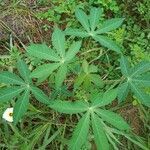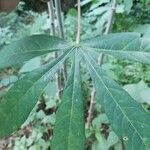Herb or shrub, sometimes arborescent, ca 1-3 m high, glabrous. Leaves with petioles 5-17 cm long; stipules lanceolate, acuminate, 7-8 mm long, deciduous; blades mostly deeply 3-5-lobed (less commonly 7-lobed, or sometimes undivided); lobes mostly elliptic-lanceolate, acuminate, glaucous beneath, the middle lobe ca 9-17 cm long, (1-)2-5 cm broad, the lateral lobes mostly smaller. Panicles 0.5-1 dm long at anthesis, lengthening in fruit; flowers on spreading or somewhat reflexed pedicels. Staminate flowers with pedicels 4-6 mm long; calyx campanulate, yellowish-green, ca 3-4.5 mm long, glabrous outside; calyx-lobes ca 2-2.5 mm long, deltoid, densely puberulent within; disc 10-lobed (i.e. of 5 concrescent bibbed segments), ca 2 mm wide; stamens 10, the filaments unequal, the longer not over 2 mm long, the anthers linear-oblong, 1.8-2 mm long, those on shorter filaments with apical tufts of hairs; pistillode absent. Pistillate flowers with pedicels 7-12 mm long, becoming ca 1.5-2 cm in fruit; calyx-lobes 5, oblong-lanceolate, acute, ca 7.5-10 mm long; disc massive, ca 3-3.5 mm wide; ovary with 6 sharp ribs or wings, the styles ca 1.8-2 mm long, dilated and divided into several capitate tips. Capsules ca 1.5 cm long, 1.3 cm in diam, rugose' and 6-winged; seeds compressed, bluntly beaked, grayish or pale brownish, dark-flecked, 7.1-9.3 mm long, 4.1-5.1 mm broad, the caruncle broadly deltoid, entire, 1.3-1.7 mm long, 2.8-3.2 mm broad.
Erect shrubs 1.5-5 m tall; root tubers terete. Stipules triangular-lanceolate, 5-7 mm, entire or with 1 or 2 bristly segments; petiole 6-35 cm, slightly peltate, inserted less than 5 mm from margin; leaf blade palmately 3-9-lobed, 5-20 cm, lobes oblanceolate to narrowly elliptic, 8-18 × 1.5-4 cm, apex acu-minate, entire; lateral veins 5-15. Racemes terminal or axillary, 5-8 cm; bracts oblong-lanceolate; pedicels 4-6 mm. Male flowers: calyx ca. 7 mm, purple-red, divided to or over middle, lobes long ovate, 3-4 × ca. 2.5 mm, hairy inside; stamens 6-7 mm; anthers white pubescent at apex. Female flowers: calyx ca. 10 mm, lobes oblong-lanceolate, ca. 8 × 3 mm; ovary ovoid, longitudinally 6-angled; stigmas recurved, plaited. Capsule ellipsoidal, 1.5-1.8 × 1-1.5 cm, longitudinally 6-winged, scabrous. Seeds slightly triangular, ca. 1 cm; testa crustaceous, smooth, with spot-stripes. Fl. Sep-Nov.
A plant which can re-grow year after year from the thickened roots. It has several stems. The stems are woody and have some branches. Plants grow up to 2 or 3 metres high. Stalks have distinct scars where leaves have fallen. The leaves tend to be near the ends of branches. The leaves are divided like the fingers on a hand. The leaves have long leaf stalks. The leaves have 3-7 long lobes which can be 20 cm long. These are widest about 1/3 of the distance from the tip and taper towards the base. The colour varies. It produces several long tubers. These can be 50 cm long by 10 cm across. The flowers are on short stalks around a central stalk. They are produced near the ends of branches. The female flowers are near the base of the flower stalk and the male flowers higher up.
Shrubs, 1–4 m. Roots thickened. Stems erect, terete when young; nodes conspicuously swollen; leaf and stipule scars elevated, especially on older stems. Leaves persistent; stipules lanceolate, entire; petiole 3–20 cm; blade basally attached, usually 3–10-lobed, sometimes unlobed, lobes without secondary lobes, median lobe 5–18 cm, margins neither thickened nor revolute, entire to ± repand, apex acuminate, surfaces glabrous or hairy, abaxial finely reticulate. Inflorescences axillary, panicles, 2–10 cm. Pedicels: staminate 2–4 mm; pistillate 20 mm in fruit, straight. Staminate flowers: calyx campanulate, 10–15 mm, lobes erect or spreading; stamens 10. Capsules 1.5 cm, usually winged. Seeds subglobose to oblong, 12 mm. 2n = 36.
Subshrub or shrub to 5 m high. Root tubers up to 50 cm long. Stipules lanceolate-triangular, 5–11 mm long. Leaves deeply palmatipartite, 3–7 lobed, the lobes oblanceolate to lanceolate or ovate, 5–17 cm long, 1–6 cm wide; base attenuate to cuneate; tip acute to acuminate. Male flowers: pedicels 2–7 mm long; calyx lobes lanceolate-triangular, 4–6 mm long, 2–4 mm wide, tube 4–6 mm long. Female flowers: pedicels 5–12 mm long; calyx lobes triangular-ovate 6–10 mm long, 2.5–5 mm wide. Fruit ovoid, 15–17 mm long, 14–15 mm diam. Seeds ellipsoid, c. 11 mm long, 5.5–5.8 mm wide. [See also Du Puy & Telford (1993: 268).]
Leaf blades 6–25 cm across, deeply palmatipartite, 3–7-lobed, rarely simple, shallowly cordate, sometimes very slightly peltate with 1–2 mm width of lamina below the petiole-insertion; the lobes usually oblanceolate, the median 6.5–15 × 2–6 cm, gradually acutely acuminate at the apex, narrowed at the base, entire, sparingly pubescent near the midrib or subglabrous, dark green above, glaucous beneath; lateral nerves up to 20 pairs.
Male flowers: pedicels 5 mm long, slender; buds 2 × 1 mm, cylindric-conic; calyx lobes 6 × 4 mm, triangular, subacute, glabrous without, pubescent within near the apex, greenish, tinged orange or crimson and sometimes purple-veined; stamen filaments slender, the longer 7 mm long, the shorter 2.5 mm long, glabrous, white, anthers 1.5 mm long, with an apical hair tuft, pale yellow; disk 10-lobed, concave, the lobes acute.
Female flowers; pedicels 7 mm long, extending to 2.5 cm and thickening to 3 mm in fruit, decurved; sepals 1× 0.5 cm, triangular-ovate, subacute; disk shallowly 5-lobed; ovary 2 × 2 mm, hexagonal, pink; styles 2 mm long, botryoidal.
Very variable in colour of bark, tint of foliage, etc. Cassava, a cultivated food-plant; native of Brazil. (See Appendix, p. 150.)
Seeds 1.1 cm × 5.5 mm × 3.5 mm, ellipsoid, depressed-pentagonal, somewhat shiny, pale grey, sometimes mottled, caruncle 3 mm wide.
Fruit 1.3–1.7 × 1.3–1.5 cm, ellipsoid-subglobose, rugulose, 6-winged, the wings undulate-subcrenate, greenish.
A brittle-stemmed dichotomously branched shrub or small tree up to 5 m tall.
Inflorescence 2–11 cm long, paniculate; bracts resembling the stipules.
Stipules 4–5 × 2 mm, triangular-lanceolate, soon falling.
Root tubers up to 50 cm long, farinaceous.
Petiole 4–25 cm long, often reddish.
Digitate leaves glaucous beneath
A shrub 6–10 ft. high, glabrous
Latex whitish, watery.
Young shoots glaucous.
Tuberous roots
A small tree.
Bark smooth.








